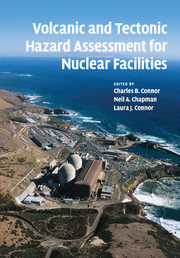Book contents
- Frontmatter
- Contents
- List of contributors
- Preface
- 1 Tectonic events and nuclear facilities
- 2 The nature of tectonic hazards
- 3 The nature of volcanism
- 4 Tectonic uplift and subsidence
- 5 Glacial isostatic adjustment: implications for glacially induced faulting and nuclear waste repositories
- 6 Using global positioning system data to assess tectonic hazards
- 7 Tectonic setting of volcanic centers in subduction zones: three-dimensional structure of mantle wedge and arc crust
- 8 Conceptual model for small-volume alkali basalt petrogenesis: implications for volcanic hazards at the proposed Yucca Mountain nuclear waste repository
- 9 Aspects of volcanic hazard assessment for the Bataan nuclear power plant, Luzon Peninsula, Philippines
- 10 Multi-disciplinary probabilistic tectonic hazard analysis
- 11 Tsunami hazard assessment
- 12 Regional-scale volcanology in support of site-specific investigations
- 13 Exploring long-term hazards using a Quaternary volcano database
- 14 Estimating spatial density with kernel methods
- 15 Cox process models for the estimation of long-term volcanic hazard
- 16 Spatial distribution of eruptive centers about the Idaho National Laboratory
- 17 Modeling the flow of basaltic magma into subsurface nuclear facilities
- 18 Intrusion dynamics for volatile-poor basaltic magma into subsurface nuclear installations
- 19 Volcanic risk assessment at Yucca Mountain, NV, USA: integration of geophysics, geology and modeling
- 20 Geological issues in practice: experience in siting US nuclear facilities
- 21 Characterizing active tectonic structures for nuclear facilities in Japan
- 22 Issues for coastal sites
- 23 Stable tectonic settings: designing site investigations to establish the tectonic basis for design and safety evaluation of geological repositories in Scandinavia
- 24 The impact of subsidence, uplift and erosion on geological repositories for radioactive wastes
- 25 Recommendations for assessing volcanic hazards at sites of nuclear installations
- 26 Formal expert assessment in probabilistic seismic and volcanic hazard analysis
- Index
- Map
6 - Using global positioning system data to assess tectonic hazards
Published online by Cambridge University Press: 27 May 2010
- Frontmatter
- Contents
- List of contributors
- Preface
- 1 Tectonic events and nuclear facilities
- 2 The nature of tectonic hazards
- 3 The nature of volcanism
- 4 Tectonic uplift and subsidence
- 5 Glacial isostatic adjustment: implications for glacially induced faulting and nuclear waste repositories
- 6 Using global positioning system data to assess tectonic hazards
- 7 Tectonic setting of volcanic centers in subduction zones: three-dimensional structure of mantle wedge and arc crust
- 8 Conceptual model for small-volume alkali basalt petrogenesis: implications for volcanic hazards at the proposed Yucca Mountain nuclear waste repository
- 9 Aspects of volcanic hazard assessment for the Bataan nuclear power plant, Luzon Peninsula, Philippines
- 10 Multi-disciplinary probabilistic tectonic hazard analysis
- 11 Tsunami hazard assessment
- 12 Regional-scale volcanology in support of site-specific investigations
- 13 Exploring long-term hazards using a Quaternary volcano database
- 14 Estimating spatial density with kernel methods
- 15 Cox process models for the estimation of long-term volcanic hazard
- 16 Spatial distribution of eruptive centers about the Idaho National Laboratory
- 17 Modeling the flow of basaltic magma into subsurface nuclear facilities
- 18 Intrusion dynamics for volatile-poor basaltic magma into subsurface nuclear installations
- 19 Volcanic risk assessment at Yucca Mountain, NV, USA: integration of geophysics, geology and modeling
- 20 Geological issues in practice: experience in siting US nuclear facilities
- 21 Characterizing active tectonic structures for nuclear facilities in Japan
- 22 Issues for coastal sites
- 23 Stable tectonic settings: designing site investigations to establish the tectonic basis for design and safety evaluation of geological repositories in Scandinavia
- 24 The impact of subsidence, uplift and erosion on geological repositories for radioactive wastes
- 25 Recommendations for assessing volcanic hazards at sites of nuclear installations
- 26 Formal expert assessment in probabilistic seismic and volcanic hazard analysis
- Index
- Map
Summary
Since the early 1990s, our understanding of plate boundary zone crustal deformation has been revolutionized by advances in global positioning system (GPS) techniques. These allow us to track directly the movement of the ground in real time, quantify the rates of crustal deformation within plate boundary zones and determine the displacement of the Earth's surface during earthquakes. The GPS measurements are taken at survey points permanently attached to the ground either by intermittent (survey-style) or continuous (daily, automated) collection of phase and pseudorange data from the constellation of GPS satellites that orbit the Earth. The GPS measurements spanning some period of time (usually longer than one year) can accurately track the movement of one point on the Earth's surface relative to others (to within a few mma−1 uncertainty). Such measurements have allowed scientists to determine where and how much tectonic strain is currently accumulating within plate boundary zones (e.g. Kreemer et al., 2000; McClusky et al., 2000; Sagiya et al., 2000; Beavan and Haines, 2001).
One of the major issues facing siting of nuclear facilities is the possibility of rapid seismic or slow aseismic strain at or near the facility. Elevated strain within a site (possibly due to a seismic event) could perturb a nuclear facility and/or jeopardize the long-term isolation of a high-level waste (HLW) repository in numerous ways, including activation/formation of faults, enhanced creep deformation of engineered barriers, flexural folding of the host rock or enhanced groundwater flow. Geological and seismological data are commonly used to assess future seismic shaking and rock deformation hazards for nuclear facilities (Stepp et al., 2001).
- Type
- Chapter
- Information
- Volcanic and Tectonic Hazard Assessment for Nuclear Facilities , pp. 156 - 175Publisher: Cambridge University PressPrint publication year: 2009
- 4
- Cited by



